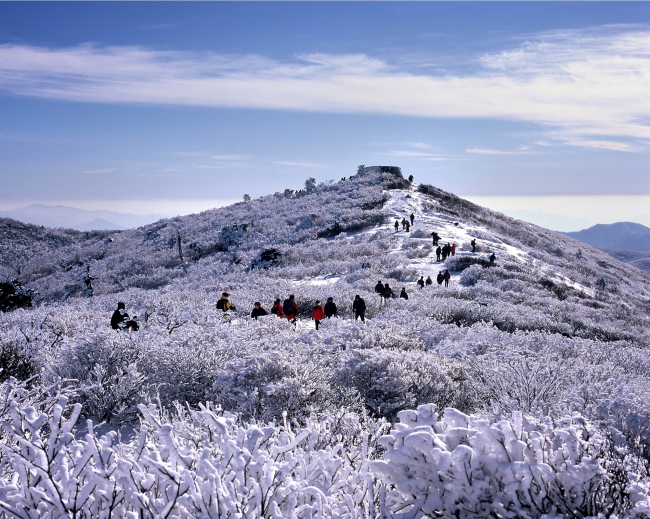With the cherry blossom season still months away, outdoor enthusiasts here are braving the elements to view a more delicate type of flower ― one that thrives in high places under harsh conditions.
“Nunkkot” (literally “snow flowers”) can be found on branches, rocks and railings, and the same chilly wind that helps create these crystal blooms can make it challenging ― or even dangerous ― to enjoy the experience.
In recent weeks, the upper elevations of the national parks of Seoraksan and Jirisan have seen temperatures of minus 15 degrees Celsius or below. Add windchill to the equation and exposed fingers freeze up in a matter of minutes, while phone and camera batteries are drained of life almost as quickly.
For those daring to face the cold, Taebaek, Gangwon Province, is an ideal starting point for a nunkkot excursion as it is the highest city in South Korea (at about 650 meters). The town is surrounded by peaks including Mount Taebaeksan, a centerpiece of the peninsula-long Taebaeksan Range and a relatively easy mountain to hike.
Geomnyongso Pond, northwest of the city, is one of the sources of the Hangang River, while Hwangjiyeonmot Pond ― right in the middle of downtown ― is the source of the Nakdonggang River. What’s more, the nation’s railroad climbs to its highest point just west of Taebaek at Chujeon Station.
 |
| Snow-covered Mount Taebaeksan (Gangwon Provincial Government) |
To reach the provincial park, take a bus from the terminal to Danggol and choose either the longer or the shorter route up to Cheonjedan Altar ― an ancient shrine dedicated to Korea’s mythological founder Dangun. Further along the ridge is Janggunbong (General) Peak, the highest in the park at 1,567 meters. From here, the path to the bottom passes a cluster of 1,000-year-old yew trees ― some alive, others dead but still standing.
The park’s western ridge ― a 1.7-kilometer stretch from the altar and the yews to Yuilsa Temple ― is the best section for nunkkot viewing, according to an official from the city’s Department of Tourism and Culture. “Snowflakes that settle on the foliage of the spreading yews form beautiful crystal flowers seen nowhere else,” the official claimed.
Looking closely, one notices that some of the formations are less like flowers and more like white plaster. In fact, the term “nunkkot” describes a wide range of cold-weather phenomena, including both hoarfrost and rime.
On her website Homelandscapes, naturalist Cathy Bell explains that in the case of rime, “needles or combs of ice grow outward, into the wind,” and that it “generally won’t form an even coating all the way around a tree branch.” On peaks and ridges of Korean mountains like Taebaeksan, rime causes the wind-stunted bushes to look like clusters of bleached coral and the boulders to look like salt under a microscope.
Hoarfrost, meanwhile, is the cold-weather equivalent of dew and appears in the form of feathery flower-like growths.
While the Korean saying “frost on top of snow” usually means “one misfortune after another,” frost is a cause for celebration for winter visitors to Mount Taebaeksan and other local peaks.
Getting there …
Until Feb. 8, KORAIL is offering a one-day train package from Seoul to Taebaek and back, allowing travelers to view the nunkkot and visit the 22nd installment of the Mount Taebaeksan Snow Festival, running until Feb. 1.
Leaving at 7:05 a.m. from Cheongnyangni Station and returning from Taebaek Station at 6:24 p.m., the “King of Nunkkot” package allows for about six hours of hiking and sightseeing. With over seven hours of train travel, though, some may prefer to design their own itinerary and stay overnight.
Note that the package costs 54,000 won while round-trip economy tickets in a normal train cost only 30,600 won. On most days, there are seven Mugunghwa and one Saemaeul train departures from Cheongyangni, and one Saemaeul departure from Seoul Station.
Buses from around the country travel to Taekbaek Intercity Bus Terminal.
By Matthew C. Crawford (mattcrawford@heraldcorp.com)



